Related Research Articles

35 mm film is a film gauge used in filmmaking, and the film standard. In motion pictures that record on film, 35 mm is the most commonly used gauge. The name of the gauge is not a direct measurement, and refers to the nominal width of the 35 mm format photographic film, which consists of strips 1.377 ± 0.001 inches (34.976 ± 0.025 mm) wide. The standard image exposure length on 35 mm for movies is four perforations per frame along both edges, which results in 16 frames per foot of film.

VistaVision is a higher resolution, widescreen variant of the 35 mm motion picture film format which was created by engineers at Paramount Pictures in 1954.

70 mm film is a wide high-resolution film gauge for motion picture photography, with a negative area nearly 3.5 times as large as the standard 35 mm motion picture film format. As used in cameras, the film is 65 mm (2.6 in) wide. For projection, the original 65 mm film is printed on 70 mm (2.8 in) film. The additional 5 mm contains the four magnetic stripes, holding six tracks of stereophonic sound. Although later 70 mm prints use digital sound encoding, the vast majority of existing and surviving 70 mm prints pre-date this technology.

To Fly! is a 1976 American short docudrama film directed by Greg MacGillivray and Jim Freeman of MacGillivray Freeman Films, who wrote the story with Francis Thompson, Robert M. Young, and Arthur Zegart. It premiered at the giant-screen IMAX theater of the National Air and Space Museum, which opened to celebrate the United States Bicentennial. The film chronicles the history of aviation in the US, with a narration written by Thomas McGrath. Thematically, it explores the search for national identity through the country's westward expansion, as well as humanity's relationship with aviation.

Star Trek IV: The Voyage Home is a 1986 American science fiction film directed by Leonard Nimoy and based on the television series Star Trek. It is the fourth feature installment in the Star Trek franchise, and is a sequel to Star Trek III: The Search for Spock (1984); it completes the story arc begun in Star Trek II: The Wrath of Khan (1982) and continued in The Search for Spock. Intent on returning home to Earth to face trial for their actions in the previous film, the former crew of the USS Enterprise finds the planet in grave danger from an alien probe attempting to contact now-extinct humpback whales. The crew travel to Earth's past to find whales who can answer the probe's call.

Lost in Space is an American science fiction television series, created and produced by Irwin Allen, which originally aired between 1965 and 1968 on CBS. The series was inspired by the 1812 novel The Swiss Family Robinson. The series follows the adventures of the Robinsons, a pioneering family of space colonists who struggle to survive in the depths of space. The show ran for 83 episodes over three seasons. The first season comprised 29 episodes that ran 1 hour apiece, filmed in black and white. In seasons 2 and 3, the episodes were 54 minutes long and shot in color.

IMAX is a proprietary system of high-resolution cameras, film formats, film projectors, and theaters known for having very large screens with a tall aspect ratio and steep stadium seating, with the 1.43:1 ratio format being available only in few selected locations.

A movie projector is an opto-mechanical device for displaying motion picture film by projecting it onto a screen. Most of the optical and mechanical elements, except for the illumination and sound devices, are present in movie cameras. Modern movie projectors are specially built video projectors.
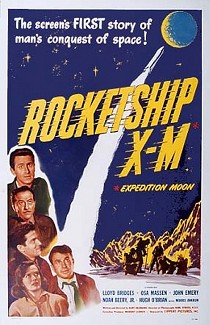
Rocketship X-M is a 1950 American black-and-white science fiction film from Lippert Pictures, the first outer space adventure of the post-World War II era. The film was produced and directed by Kurt Neumann and stars Lloyd Bridges, Osa Massen, John Emery, Noah Beery Jr., Hugh O'Brian, and Morris Ankrum.
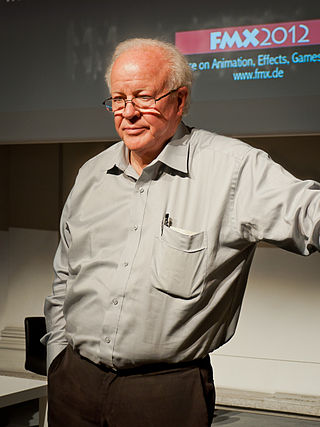
Douglas Hunt Trumbull was an American film director and innovative visual effects supervisor. He pioneered methods in special effects and created scenes for 2001: A Space Odyssey, Close Encounters of the Third Kind, Star Trek: The Motion Picture, Blade Runner and The Tree of Life, and directed the movies Silent Running and Brainstorm.
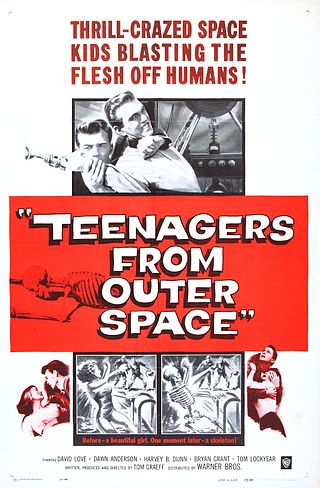
Teenagers from Outer Space is a 1959 American independent black-and-white science fiction cult film released by Warner Bros. The film was produced, written and directed by Tom Graeff and stars David Love, Dawn Bender, Bryan Grant, Harvey B. Dunn, Tom Graeff and King Moody. Teenagers from Outer Space was distributed theatrically by Warner Bros. on a double feature with Gigantis the Fire Monster, the English-dubbed version of the 1955 Japanese giant monster film Godzilla Raids Again.
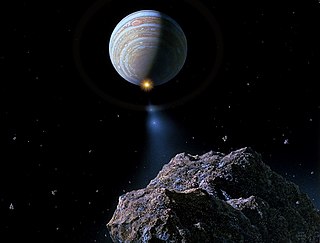
Don Davis is a space artist known for his portrayals of space-related subjects. His work is characterised by attention to detail and authentic portrayals based on what is known of the subject. Chesley Bonestell, considered by many to be one of the most accomplished practitioners of the space art genre, critiqued Davis' early paintings and encouraged him to pursue an artistic career.
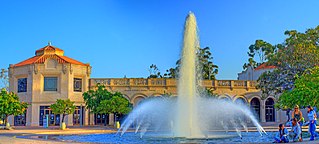
The Fleet Science Center is a science museum and planetarium in Balboa Park, located in San Diego, California. It is at the east end of the El Prado Drive walkway, next to the Bea Evenson Fountain and plaza in central Balboa Park.
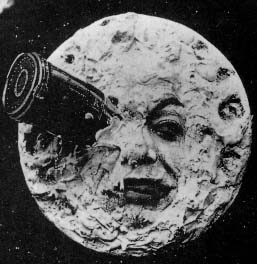
The history of science fiction films parallels that of the motion picture industry as a whole, although it took several decades before the genre was taken seriously. Since the 1960s, major science fiction films have succeeded in pulling in large audience shares, and films of this genre have become a regular staple of the film industry. Science fiction films have led the way in special effects technology, and have also been used as a vehicle for social commentary.
Super Panavision 70 is the marketing brand name used to identify movies photographed with Panavision 70 mm spherical optics between 1959 and 1983.
Queen of Blood is a 1966 science fiction horror film produced by George Edwards and Samuel Z. Arkoff, directed by Curtis Harrington, that stars John Saxon, Basil Rathbone, Dennis Hopper, and Judi Meredith. The film is based on the screenplay for the earlier Soviet feature film Mechte Navstrechu. Director Harrington also reused special effects footage from that film, as well as footage from the Soviet science fiction film Nebo Zovyot.
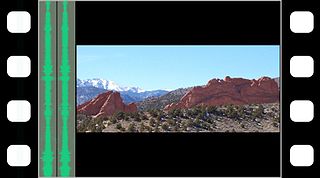
Anamorphic format is the cinematography technique of shooting a widescreen picture on standard 35 mm film or other visual recording media with a non-widescreen native aspect ratio. It also refers to the projection format in which a distorted image is "stretched" by an anamorphic projection lens to recreate the original aspect ratio on the viewing screen. The word anamorphic and its derivatives stem from the Greek anamorphoo, compound of morphé with the prefix aná. In the late 1990s and 2000s, anamorphic lost popularity in comparison to "flat" formats such as Super 35 with the advent of digital intermediates; however, in the years since digital cinema cameras and projectors have become commonplace, anamorphic has experienced a considerable resurgence of popularity, due in large part to the higher base ISO sensitivity of digital sensors, which facilitates shooting at smaller apertures.
Lester Novros was an American artist, animator, and teacher.

Ring of Fire is a 1991 documentary film in IMAX format. It looks at some of the varieties of volcanism and earthquake activity in the Ring of Fire, around the Pacific Rim. The film runs 40 minutes.

Colin James Cantwell was an American concept artist and director known for his work on films like 2001: A Space Odyssey and WarGames, but primarily for doing initial concept designs and models for a number of Star Wars vehicles, most notably the X-wing fighter, the TIE fighter, and the Death Star, that were then further developed by people like Ralph McQuarrie and Joe Johnston.
References
- ↑ Greg Bear (2017). "The Reuben H. Fleet Space Theater: the Early Years, and Before" . Retrieved 2021-06-19.
- ↑ George Casey, president of Graphic Films, American Cinematographer , August 1973.
- ↑ Mary Anderson, console operator at the Reuben H. Fleet Science Center